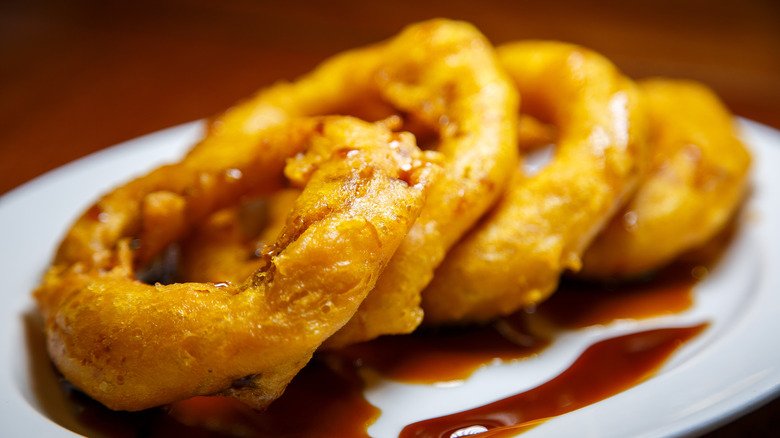Picarones: The Peruvian Sweet Potato Donut You Need To Know
Peru is home to so many dishes that combine cooking methods and flavor profiles of other cultures with local ingredients. Take, for example, ceviche, Peru's beloved raw fish dish cooked in citrus, which became what it is today with the introduction of Japanese styles of sashimi by the Nikkei (Japanese immigrants), per National Geographic. Or think about the fiery, soy sauce beef stir fry, Lomo Saltado, which combined Chinese cooking with Peruvian flavors, via New Worlder.
Like a lot of traditional Peruvian dishes, picarones were inspired by dishes from foreigners. A descendant of the Spanish buñuelo, the picarone is a golden brown fritter that uses distinctly Peruvian ingredients and spices, per Atlas Obscura. At first glance, they may not look so different from donuts, but they are actually quite distinct due to the key ingredients in the batter.
What do picarones taste like?
Imagine the crispy texture of a fresh beignet. Now, imagine the pillowy, yeasty inside of every great donut you've ever had — picarones have these components and more. Because they're always freshly made by street vendors, you will hardly come across a dense and soggy picarone.
Picarones have a spiced flavor that Americans would most likely describe as "fall flavor" or "pumpkin spice flavor." The batter is mostly made up of tubers, usually, a mixture of sweet potato and a local squash found in Peru called macre, per Peru Delights. The yeasty dough is spiced with cinnamon and cloves, and once the dough is fried, it's covered in a sticky, spiced molasses, that resembles thicker maple syrup. You could almost imagine what this delectable treat would taste like since it is made from squash and cinnamon and covered in sticky syrup. In layman's terms, it would most closely resemble a fall-flavored beignet, with a crispier exterior.
How are picarones made?
Making this Peruvian snack is a bit more involved than preparing a standard glazed doughnut. First of all, you have to peel and chop the macre or squash and sweet potatoes, and then boil them until they are soft enough to macerate, per Lima Easy. Lima Easy suggests that you boil these in water with cinnamon sticks, anise seeds, and cloves to soak in the tubers in spice. Afterward, you mash them into a smooth puree to which you add your bloomed yeast. Like every yeasty bread, you wait for the yeast to bloom, and then, you add your flour.
While you let your dough rest, you create your chancaca syrup by combining cinnamon, cloves, orange peels, and chancaca sugar in a pot, per Lima Easy. Once your dough doubles in size, you use wet fingers to gently grab a piece to drop in hot oil. The dough is much more sticky and gloppy than regular doughnut dough, which is why the finished product comes out looking misshapen, like fritters. After you fry them, you drizzle that deeply spiced chancaca sauce on top and enjoy!
What is chancaca syrup?
That amber-colored syrup that's drizzled on picarones is chancaca syrup. Chancaca syrup is more intense and sticky than most doughnut glazes since it doesn't harden or cool when left at room temperature. Chancaca syrup is an orange-flavored molasses that is made of chancaca sugar, which looks like dark brown sugar. According to Delighted Cooking, chancaca sugar is made of a dark liquid that comes out as a byproduct during the production of white cane sugar. It is believed that this liquid contains all of the naturally occurring nutrients in sugar that are extracted from white cane sugar. Of course, the simplest form is the orange-flavored chancaca syrup, but you can also add spices such as cinnamon, anise seeds, and cloves to elevate your chancaca syrup like Lima Easy suggests.
Chancaca syrup's dark brown color isn't just an aesthetic attribute — chancaca syrup has a richer, more caramelized flavor than simple syrup, so it becomes an excellent glaze for sweet potato-based doughnuts like picarones.
Where are picarones from?
As mentioned earlier, picarones were inspired by Spanish buñuelos, which are deep-fried dough balls. In fact, What's Cooking America states that buñuelos are still popular snacks in Mexico, Columbia, and Cuba, although each country has its own variation of the Spanish treat.
According to Atlas Obscura, when the Spaniards brought buñuelos over to Latin America during the Age of Exploration, enslaved Africans who were brought to Peru made a variation of the original fritter by using ingredients they had available to them. Picarones became distinct from the buñuelos due to the base mixture of macre and sweet potato, which gave them a delightfully sweet flavor.
Blending the buñuelos with African cooking techniques and Peruvian ingredients, picarones reveal the diversity of Peruvian cuisine. These deep-fried snacks are a beloved Peruvian street food that continues to draw natives and foreigners alike with their caramel flavor and delectable crunch. Try making your own picarones at home with butternut squash and sweet potato, or explore other types of doughnuts around the world.




